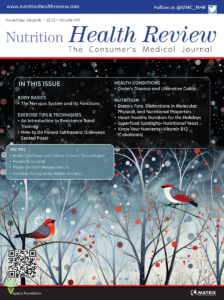 According to the Institute for Integrative Nutrition, “Chrononutrition is the study of how nutrition relates to your body’s circadian rhythm, the internal clock that governs the physical, mental, and emotional cycles of your body. Your circadian rhythm is most affected by light and darkness, and influences sleep, body temperature, hormones, and appetite.”1 It has been observed that food and feeding patterns act as external cues that can alter circadian rhythm,2 but more research is needed to better understand the relationship between circadian rhythm, appetite, timing of meals, and overall health. The scientific community has produced some interesting findings, which continue to shed light on the impact meal timing can have on our overall health. Here, we provide brief summaries of some of the more recent research in chrononutrition.
According to the Institute for Integrative Nutrition, “Chrononutrition is the study of how nutrition relates to your body’s circadian rhythm, the internal clock that governs the physical, mental, and emotional cycles of your body. Your circadian rhythm is most affected by light and darkness, and influences sleep, body temperature, hormones, and appetite.”1 It has been observed that food and feeding patterns act as external cues that can alter circadian rhythm,2 but more research is needed to better understand the relationship between circadian rhythm, appetite, timing of meals, and overall health. The scientific community has produced some interesting findings, which continue to shed light on the impact meal timing can have on our overall health. Here, we provide brief summaries of some of the more recent research in chrononutrition.
Time Restricted Eating: A Dietary Strategy to Prevent and Treat Metabolic Disturbances
Time-restricted eating (TRE) is a dietary approach that limits the daily eating window. Small (8–80 participants), short-term (4–12 weeks) trials reported modest weight loss, decreased feelings of hunger and desire to eat, lower blood pressure, reduced inflammatory markers, and reduced oxidative stress markers. However, the effects of TRE on glucose and lipid metabolism are mixed. Though some studies observed significantly lower fasting glucose and fasting insulin levels, decreased insulin resistance, and increased insulin sensitivity among participants, others observed no such benefits. Reports on improvements in lipid metabolism, which includes triglyceride and cholesterol levels, are also inconsistent. Therefore, further investigation with different study designs and subject cohorts should be undertaken to fully understand the effects of TRE on metabolic health.2
Timing of Breakfast, Lunch, and Dinner: Effects on Obesity and Metabolic Risk
Researchers from the University of Murcia in Spain found that unusual eating times can produce a disruption in the circadian system that might lead to unhealthy consequences. The investigators reviewed and analyzed multiple studies on the timing of the three main meals of the day—breakfast, lunch, and dinner—and its potential impact on metabolism, glucose tolerance, and obesity-related factors. According to their analysis, breakfast skipping is causally linked to obesity, and late lunch (after 3pm) hinders weight loss, mainly in those carriers of a specific genetic variant. They also found that late lunch was associated with worsened gut microbiota diversity and composition, and late dinner (within two hours before bedtime) decreases glucose tolerance, again especially in those carrying a specific gene variant. In addition, the researchers found that individual chronotype is important in obesity. In evening chronotypes, (i.e., those who eat at night during the two hours before sleep), the probability of being obese increased five times, while in morning chronotypes (i.e., those who take in the most calories during two hours after morning wake time), the probability of being obese decreased by 50 percent.3
Meal Timing and Frequency: Implications for Cardiovascular Disease Prevention: A Scientific Statement from the American Heart Association
According to a study by the American Heart Association Obesity Committee of the Council on Lifestyle and Cardiometabolic Health; the Council on Cardiovascular Disease in the Young; the Council on Clinical Cardiology; and the Stroke Council, irregular patterns of total energy intake (TEI) can negatively impact body weight maintenance and cardiometabolic health. The researchers recommend taking an intentional approach to eating that focuses on the timing and frequency of meals and snacks (i.e., eating at planned intervals to distribute energy intake throughout the day) for better health and reduced risk factors for heart disease. According to the researchers, focusing on meal frequency and timing may help individuals improve the quality of the food they eat, which can promote weight loss and/or weight maintenance without the need to restrict calories. Spreading one’s meals and snacks over a defined period of time during the day in a more balanced way is encouraged, as opposed to consuming the bulk of one’s daily calories during a single window of time during the day (or night) or continuously grazing over long periods of time.4
Associations between Fasting Duration, Timing of First and Last Meal, and Cardiometabolic Endpoints in the National Health and Nutrition Examination Survey
Using cross-sectional data collected in 2-year cycles from 2005 to 2016, researchers assessed the association between fasting and cardiometabolic health. They found that every one-hour increase in fasting led to an average increase in insulin and C-reactive protein (CRP) and decrease in high-density lipoprotein (HDL), and these changes were significantly different between quartile 4 (longest fasting duration) and quartile 1 (shortest fasting duration). Those with the latest last mealtimes had higher levels of HbA1c and insulin and lower levels of low-density lipoprotein (LDL) and total cholesterol than those with the earliest last mealtimes. The authors also found that every one-hour increase in first mealtime was associated with higher CRP, insulin, HbA1c, and glucose, as well as lower HDL. However, this study is limited by the fact the fasting periods from night to morning could not be truly estimated, so last and first mealtimes had to be estimated.5
A Higher Intake of Energy at Dinner is Associated with Incident Metabolic Syndrome: A Prospective Cohort Study in Older Adults
A higher energy intake (EI) at night has been associated with a higher risk of obesity, while a higher EI at lunch may protect against weight gain. Hermenegildo-López et al examined the association between EI throughout the day and incident metabolic syndrome (MetS) among older adults. A cohort of 607 individuals 60 years of age or older who were free from MetS at baseline was followed from the years 2008 to 2015. At baseline, habitual EI was assessed on six eating occasions: breakfast, mid-morning snack, lunch, afternoon snack, dinner, and other snacking. During follow-up, 101 new MetS cases occurred. Analyses of the data indicated that a higher EI at dinner was associated with a higher risk of MetS in older adults. Reducing EI at dinner might be a simple strategy to prevent MetS.6
Eating Dinner Early Improves 24-hour Blood Glucose Levels and Boosts Lipid Metabolism after Breakfast the Next Day: A Randomized Cross-Over Trial
Investigators examined whether mild early TRE (eating dinner at 6:00pm vs. 9pm) improves 24-hour blood glucose levels and postprandial lipid metabolism in healthy adults. The study included 12 participants (2 men, 10 women). In this three-day (until the morning of Day 3), randomized, crossover study, two different conditions were tested: eating a late dinner (at 9pm) or an early dinner (at 6pm). During the experimental period, blood glucose levels were evaluated by each participant wearing a continuous blood glucose measuring device. Metabolic measurements were performed using the indirect calorimetry method on the morning of Day 3. The study was conducted over three days; Day 1 was excluded from the analysis to adjust for the effects of the previous day’s meal, and only data from the mornings of Days 2 and 3 were used for the analysis. Significant differences were observed in mean 24-hour blood glucose levels on Day 2 between the two groups. There was a significant decrease in the postprandial respiratory quotient 30 minutes and 60 minutes after breakfast on Day 3 in the early dinner group compared with the late dinner group. Despite a difference of only 3 hours, investigators observed that eating dinner early (at 6pm) had a positive effect on blood glucose level fluctuation and substrate oxidation compared with eating dinner late (at 9pm).7 These results are limited by the small number of study participants.
Bottom Line
Since chrononutrition is a relatively new field of study, more research is needed to determine its effects on our health. If you are interested in attempting this dietary method, consult with a doctor or nutritionist.
Sources
1. Institute for Integrative Nutrition site. Chrononutrition: the importance of meal timing. Published 24 Feb 2018. Updated 25 Jan 2021. https://www.integrativenutrition.com/blog/chrononutrition-meal-timing. Accessed 22 Oct 2021.
2. Schuppelius B, Peters B, Ottawa A, Pivovarova-Ramich O. Time restricted eating: a dietary strategy to prevent and treat metabolic disturbances. Front Endocrinol (Lausanne). 2021;12:683140. doi:10.3389/fendo.2021.683140.
3. Lopez-Minguez J, Gómez-Abellán P, Garaulet M. Timing of breakfast, lunch, and dinner: effects on obesity and metabolic risk. Nutrients. 2019;11(11):2624. Published online 2019 Nov 1. doi: 10.3390/nu11112624.
4. St-Onge M-P, Ard J, Baskin ML, et al. Meal timing and frequency: implications for cardiovascular disease prevention: a scientific statement from the American Heart Association. Circulation. 2017;135:e96–e121. doi: 10.1161/CIR.0000000000000476.
5. Wirth MD, Zhao L, Turner-McGrievy GM, Ortaglia A. Associations between fasting duration, timing of first and last meal, and cardiometabolic endpoints in the National Health and Nutrition Examination Survey. Nutrients. 2021;13(8):2686.doi:10.3390/nu13082686.
6. Hermenegildo-López Y, Donat-Vargas C, Sandoval-Insausti H, et al. A higher intake of energy at dinner is associated with incident metabolic syndrome: a prospective cohort study in older adults. Nutrients. 2021;13(9):30–35. Published online 2021 Aug 30. doi: 10.3390/nu13093035.
7. Nakamura K, Tajiri E, Ando T, et al. Eating dinner early improves 24-h blood glucose levels and boosts lipid metabolism after breakfast the next day: a randomized cross-over trial. Nutrients. 2021;13(7):2424. Published online 2021 Jul 15. doi: 10.3390/nu13072424.





